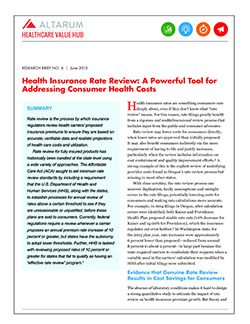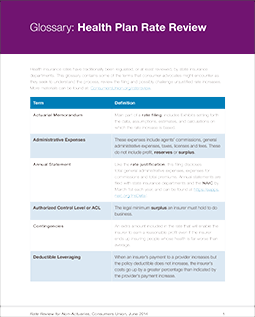Improving Value
Insurance Rate Review
Rate review is the process by which insurance regulators review health carriers' proposed insurance premiums1 to ensure they are based on accurate, verifiable data and realistic projections of healthcare costs and utilization.
Rate review has historically been conducted at the state-level using a wide variety of approaches. The Affordable Care Act sought to establish minimum acceptability standards for rate review, which include a requirement to create a process for annually reviewing rates above a certain threshold to determine if they are "unreasonable" or unjustified before the plans are sold to consumers. Current federal regulations require such a review whenever a carrier proposes an annual premium rate increase in excess of 10 percent; however, states have the autonomy to adopt lower thresholds. Additionally, the U.S. Department of Health and Human Services is tasked with reviewing proposed rates for states that fail to establish an "effective" rate review program.2,3 This designation reflects consideration of basic factors, like medical cost trends, expected utilization of services and determinations about the reasonableness of rate increases.
Recommendations
Considerable variation in how states approach rate review has surfaced some best practices. Using a rigorous, multidimensional review process, which includes input from the public and consumer advocates, has been shown to lower rates for consumers. States should also assess whether they need to:
- Change the threshold for review to include more filings;
- Provide better public access to rate review information;
- Couple rate review with prior approval authority and/or an active purchaser exchange; and
- Expand the range of factors that can be considered during rate review.
Bring Affordability into Rate Review
State insurance regulators, in their role as stewards of the consumer-insurer contract, should lead the charge in promoting cost containment to make premiums more affordable for consumers. Rate review is a prime opportunity for these regulators (as well as consumer advocates and the public) to scrutinize coverage prices; underlying assumptions about medical trends; and the presence or absence of interventions to address high unit prices and wasteful spending.
While some regulators monitor health plans' efforts to address the underlying provider, hospital and drug prices we pay (i.e., the "medical trend"), many focus solely on expenses directly under health plans' control (e.g., administrative expenses) and the expected enrollee mix. This narrow lens may be insufficient when it comes to meaningfully reducing consumers' insurance costs.
A few states (California, Massachusetts, Oregon, Rhode Island, Vermont and Washington) have expanded the factors considered during rate review in attempt to improve affordability for consumers. For example:
- Rhode Island's Office of the Health Insurance Commissioner established a comprehensive set of standards designed to encourage insurance companies and hospitals to reduce costs by creating more efficient systems, not by lowering the quality of care or reducing coverage. Strategies include requiring insurers to invest more in primary care providers and services and encouraging primary care practices to transform into patient-centered medical homes and reducing costs through the adoption of payment reform strategies.4
- California requires health plans to disclose information on recent cost containment efforts for all rate filings submitted in the individual and small group insurance markets to the Department of Managed Care.5
- The Massachusetts Department of Insurance can require issuers to provide a detailed description of the basis upon which they pay different rates to "similarly situated" providers.6 The state's Health Policy Commission can request and review issuer-provider contracts as part of its mandate to reduce healthcare cost growth in the state.
- Oregon's Department of Consumer and Business Services has the authority to request data on insurance companies' cost containment and quality improvement efforts through rate filings.7 Moreover, rates may not be deemed "prejudicial to the interests of the insured's policyholders."8
- Insurance regulators in Washington state have the authority to review provider contracts — critical for learning how monopoly power might be affecting rates in local markets.
Work Closely with the State's All-Payer Claims Database9
State regulators that have access to an all-payer claims database (APCD) are ahead of the game in terms of their ability to analyze proposed insurance rates. For example, the Maryland Insurance Administration uses the state's APCD — the MD Medical Care Database — to check payer submissions and run deeper analyses. Oregon's Department of Consumer and Business Services uses its APCD data to aid the review of individual and small group health plan premiums. Additionally, Massachusetts' Center for Health Information and Analysis has worked in partnership with the state's Division of Insurance to reduce the statewide payer reporting burden by directly sourcing several insurance reports from its APCD (supporting "administrative simplification").
Facilitate Public Participation
Finally, regulators should use a rate review process that encourages input and participation from employers, consumers, consumer advocates and other stakeholders to ensure a 360 degree view of health spending, patient experience and affordability.
Notes
1. State regulators only perform this function for "fully-insured" products sold in the state's insurance marketplace. Large employers typically offer "self-insured" coverage, which is regulated by the U.S. Department of Labor.
2. Information about "effective" rate review can be found on CMS' website: https://www.cms.gov/CCIIO/Programs-and-Initiatives/Health-Insurance-Market-Reforms/Review-of-Insurance-Rates
3. CMS' "effective" rate review designation does not take affordability, high-value care, or the scrutiny of provider contratcs into account.
4. Office of the Health Insurance Commissioner: State of Rhode Island, "Reform and Policy - Affordability Standards," http://www.ohic.ri.gov/ohic-reformandpolicy-affordability.php (accessed on Jan. 8, 2020).
5. The department does not have the authority to approve or deny rate increases.
6. See: https://www.mass.gov/files/documents/2016/07/xk/211-cmr-43-00-emergencycleanversion.pdf and https://www.mass.gov/files/documents/2017/11/08/211-66.pdf
7.Oregon Division of Financial Regulation, "Comparing Health Insurer Quality and Cost," https://dfr.oregon.gov/healthrates/comparing-quality/Pages/comparing-quality.aspx/healthrates/comparing-quality/Pages/comparing-quality.aspx (accessed on Jan. 8, 2020).
8. Oregon Division of Financial Regulation, "Rate Regulation," https://dfr.oregon.gov/business/reg/reports-data/annual-health-insurance-report/Pages/rate-regulation.aspx (accessed on Jan. 8, 2020).
9. All-payer claims databases (APCDs) are centralized state data repositories for health insurance membership and claims records.








